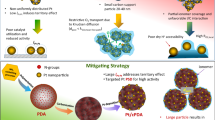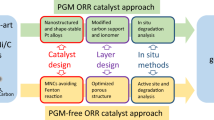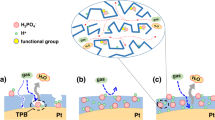Abstract
The reduction of Pt content in the cathode for proton exchange membrane fuel cells is highly desirable to lower their costs. However, lowering the Pt loading of the cathodic electrode leads to high voltage losses. These voltage losses are known to originate from the mass transport resistance of O2 through the platinum–ionomer interface, the location of the Pt particle with respect to the carbon support and the supports’ structures. In this study, we present a new Pt catalyst/support design that substantially reduces local oxygen-related mass transport resistance. The use of chemically modified carbon supports with tailored porosity enabled controlled deposition of Pt nanoparticles on the outer and inner surface of the support particles. This resulted in an unprecedented uniform coverage of the ionomer over the high surface-area carbon supports, especially under dry operating conditions. Consequently, the present catalyst design exhibits previously unachieved fuel cell power densities in addition to high stability under voltage cycling. Thanks to the Coulombic interaction between the ionomer and N groups on the carbon support, homogeneous ionomer distribution and reproducibility during ink manufacturing process is ensured.
This is a preview of subscription content, access via your institution
Access options
Access Nature and 54 other Nature Portfolio journals
Get Nature+, our best-value online-access subscription
$29.99 / 30 days
cancel any time
Subscribe to this journal
Receive 12 print issues and online access
$259.00 per year
only $21.58 per issue
Buy this article
- Purchase on Springer Link
- Instant access to full article PDF
Prices may be subject to local taxes which are calculated during checkout





Similar content being viewed by others
Data availability
The data supporting the findings of this study are available within this article and its Supplementary Information files, or from the corresponding author upon reasonable request. The Supplementary Information contains descriptions of methods, discussion on physicochemical characterization and the electrochemical characterization of as-prepared/conducted CO stripping, polarization curves, limiting current measurements and accelerated stress testing. It also includes Supplementary Figs. 1–12 and Supplementary Tables 1–8.
References
US DRIVE Partnership. Fuel Cell Technical Team Roadmap, June 2013 https://energy.gov/sites/prod/files/2014/02/f8/fctt_roadmap_june2013.pdf (2013).
Ohma, A. et al. Analysis of proton exchange membrane fuel cell catalyst layers for reduction of platinum loading at Nissan. Electrochimica Acta 56, 10832–10841 (2011).
Ohma, A., Fushinobu, K. & Okazaki, K. Influence of Nafion film on oxygen reduction reaction and hydrogen peroxide formation on Pt electrode for proton exchange membrane fuel cell. Electrochimica Acta 55, 8829–8838 (2010).
Jinnouchi, R., Kudo, K., Kitano, N. & Morimoto, Y. Molecular ynamics simulations on O2 permeation through Nafion ionomer on platinum surface. Electrochimica Acta 188, 767–776 (2016).
Shinozaki, K., Morimoto, Y., Pivovar, B. S. & Kocha, S. S. Suppression of oxygen reduction reaction activity on Pt-based electrocatalysts from ionomer incorporation. J. Power Source. 325, 745–751 (2016).
Yarlagadda, V. C. et al. Boosting fuel cell performance with accessible carbon mesopores. ACS Energy Lett. 3, 618–621 (2018).
Lopez-Haro, M. et al. Three-dimensional analysis of Nafion layers in fuel cell electrodes. Nat. Commun. 5, 5229 (2014).
Orfanidi, A. et al. The key to high performance low Pt loaded electrodes. J. Electrochem. Soc. 164, F418–F426 (2017).
Sun, L.-X. & Okada, T. Studies on interactions between Nafion and organic vapours by quartz crystal microbalance. J. Memb. Sci. 183, 213–221 (2001).
Miyazaki, K. et al. Aminated perfluorosulfonic acid ionomers to improve the triple phase boundary region in anion exchange membrane fuel cells. J. Electrochem. Soc. 157, A1153–A1157 (2010).
Owejan, J. P., Owejan, J. E. & Gu, W. Impact of platinum loading and catalyst layer structure on PEMFC performance. J. Electrochem. Soc. 160, F824–F833 (2013).
Jansen, R. J. J. & van Bekkum, H. XPS of nitrogen-containing functional groups on activated carbon. Carbon 33, 1021–1027 (1995).
Ortega, K. F., Arrigo, R., Frank, B., Schlögl, R. & Trunschke, A. Acid–base properties of N-doped carbon nanotubes: a combined temperature-programmed desorption, X-ray photoelectron spectroscopy, and 2-propanol reaction investigation. Chem. Mat. 28, 6826–6839 (2016).
Mikhail, R. S., Brunauer, S. & Bodor, N. E. E. Investigations of a complete pore structure analysis. J. Colloid Inter. Sci. 26, 45–53 (1968).
Lowell, S., Shields, J. E., Thomas, M. A. & Thommes, M. Characterization of Porous Solids and Powder: Surface Area, Pore Size and Density (Kluwer Academic, 2004).
Jaouen, F. & Dodelet, J.-P. Non-noble electrocatalysts for O2 reduction: how does heat treatment affect their activity and structure? Part I. Model for carbon black gasification by NH3: parametric calibration and electrochemical validation. J. Phys. Chem. C. 111, 5963–5970 (2007).
Sherwood, T. K., Gilliland, E. R. & Ing, S. W. Hydrogen cyanide synthesis from elements and from ammonia and carbon. Indust. Eng. Chem. 52, 601–604 (1960).
Arrigo, R., Hävecker, M., Schlögl, R. & Su, D. S. Dynamic surface rearrangement and thermal stability of nitrogen functional groups on carbon nanotubes. Chem. Comm. 40, 4891–4893 (2008).
Harzer, G. S., Orfanidi, A., El-Sayed, H., Madkikar, P. & Gasteiger, H. A. Tailoring catalyst morphology towards high performance for low Pt loaded PEMFC cathodes. J. Electrochem. Soc. 165, F770–F779 (2018).
Park, Y.-C., Tokiwa, H., Kakinuma, K., Watanabe, M. & Uchida, M. Effects of carbon supports on Pt distribution, ionomer coverage and cathode performance for polymer electrolyte fuel cells. J. Power Source. 315, 179–191 (2016).
Neyerlin, K. C., Gu, W., Jorne, J. & Gasteiger, H. A. Determination of catalyst unique parameters for the oxygen reduction reaction in a PEMFC. J. Electrochem. Soc. 153, A1955–A1963 (2006).
Kabir, S., Artyushkova, K., Serov, A. & Atanassov, P. Role of nitrogen moieties in N-doped 3D-graphene nanosheets for oxygen electroreduction in acidic and alkaline media. ACS App. Mat. Int. 10, 11623–11632 (2018).
Lai, L. et al. Exploration of the active center structure of nitrogen-doped graphene-based catalysts for oxygen reduction reaction. Energy Environ. Sci. 5, 7936 (2012).
Yang, S. et al. Efficient synthesis of heteroatom (N or S)-doped graphene based on ultrathin graphene oxide-porous silica sheets for oxygen reduction reactions. Adv. Funct. Mat. 22, 3634–3640 (2012).
Artyushkova, K. et al. Role of surface chemistry on catalyst/ionomer interactions for transition metal–nitrogen–carbon electrocatalysts. ACS Appl. Energy Mat. 1, 68–77 (2017).
Ohma, A. et al. Membrane and catalyst performance targets for automotive fuel cells by FCCJ membrane. ECS Trans. 41, 775–784 (2011).
Kongkanand, A. & Mathias, M. F. The priority and challenge of high-power performance of low-platinum proton-exchange membrane fuel cells. J. Phys. Chem. Lett. 7, 1127–1137 (2016).
Orfanidi, A., Rheinlander, P. J., Schulte, N. & Gasteiger, H. A. Ink solvent dependence of the ionomer distribution in the catalyst layer of a PEMFC. J. Electrochem. Soc. 165, F1254–F1263 (2018).
Harzer, G. S., Schwammlein, J. N., Damjanovic, A. M., Ghosh, S. & Gasteiger, H. A. Cathode loading impact on voltage cycling induced PEMFC degradation: a voltage loss analysis. J. Electrochem. Soc. 165, F3118–F3131 (2018).
Schmies, H. et al. Impact of carbon support functionalization on the electrochemical stability of Pt fuel cell catalysts. Chem. Mater. 30, 7287–7295 (2018).
Zhou, Y. et al. Enhancement of Pt and Pt-alloy fuel cell catalyst activity and durability via nitrogen-modified carbon supports. Energy Environ. Sci. 3, 1437–1446 (2010).
Shi, W. et al. Enhanced stability of immobilized platinum nanoparticles through nitrogen heteroatoms on doped carbon supports. Chem. Mater. 29, 8670–8678 (2017).
Baker, D. R. C. C. A., Neyerlin, K. C. & Murph, M. W. Measurement of oxygen transport resistance in PEM fuel cells by limiting current methods. J. Electrochem. Soc. 156, B991–B1003 (2009).
Caulk, D. A. & Baker, D. R. Heat and water transport in hydrophobic diffusion media of PEM fuel cells. J. Electrochem. Soc. 157, B1237–B1244 (2010).
Acknowledgements
This work was supported by the BMW Group. We also thank the members of FC Test Field, FC Technology Development and Technology Material Analysis of BMW Group for their support during fuel cell testing, MEA manufacturing and decal preparation.
Author information
Authors and Affiliations
Contributions
A.O. conceived the project. S.O. synthesized all the samples. S.O. and A.O. carried out the MEA manufacturing, fuel cell experiments and data analysis. H.S. and B.A. contributed to material synthesis including ammonolysis. H.N.N. conducted and analysed XPS measurements. J.H. conducted and analysed nitrogen physisorption measurements. U.G. carried out SEM/STEM measurements. M.G. carried out TGA measurements. P.S. provided guidance and constructive ideas throughout the project to ensure the successful outcome of this project. All authors contributed to the discussion part, drew conclusions and participated in finalizing the text and figures.
Corresponding authors
Ethics declarations
Competing interests
The authors declare no competing interests.
Additional information
Publisher’s note Springer Nature remains neutral with regard to jurisdictional claims in published maps and institutional affiliations.
Supplementary information
Rights and permissions
About this article
Cite this article
Ott, S., Orfanidi, A., Schmies, H. et al. Ionomer distribution control in porous carbon-supported catalyst layers for high-power and low Pt-loaded proton exchange membrane fuel cells. Nat. Mater. 19, 77–85 (2020). https://doi.org/10.1038/s41563-019-0487-0
Received:
Accepted:
Published:
Issue Date:
DOI: https://doi.org/10.1038/s41563-019-0487-0
This article is cited by
-
Nanoscopic Post-Compression Effects on Transport Phenomena and Electrochemical Utilization in Quaternion Catalyst Layers for Fuel Cell Applications
International Journal of Precision Engineering and Manufacturing-Green Technology (2024)
-
Conversion of CO2 to multicarbon products in strong acid by controlling the catalyst microenvironment
Nature Synthesis (2023)
-
Three-dimensional nanoimaging of fuel cell catalyst layers
Nature Catalysis (2023)
-
Interfacial assembly of binary atomic metal-Nx sites for high-performance energy devices
Nature Communications (2023)
-
Blocking the sulfonate group in Nafion to unlock platinum’s activity in membrane electrode assemblies
Nature Catalysis (2023)



